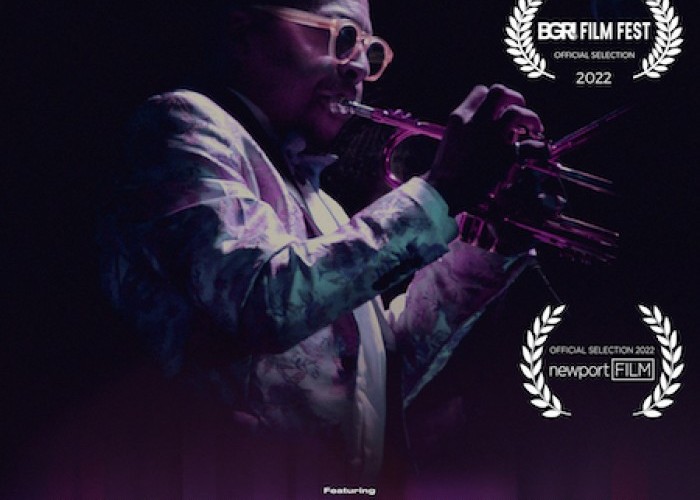Oct 28, 2025 10:47 AM
In Memoriam: Jack DeJohnette, 1942–2025
Jack DeJohnette, a bold and resourceful drummer and NEA Jazz Master who forged a unique vocabulary on the kit over his…

The vérité documentary Hargrove showcases the late trumpeter in various locations with different groups.
(Photo: )There is a poignant moment, almost like a musical epitaph, toward the end of Hargrove, a documentary of the late trumpeter, where he’s sitting alone in what appears to be a window sill, working his way through Frank Loesser and Jimmy McHugh’s “Say It (Over & Over Again).” In a slow dirge-like pace, the beautiful melody eases from his horn, at times given a quick flurry of notes. It’s a mournful tune that in its haunting treatment signals the film’s sorrow and sadness. But in contrast to this extended lament are those swift exciting executions, the bravura passages that typified Roy Hargrove at the peak of a performance, and director Eliane Henri has tastefully and strategically placed them to either enhance commentary or to let the film breathe free of too many talking heads.
Even so, the notables she has summoned to speak to Hargrove’s style, whether on the bandstand, his apparel or his musical tendencies are highly informed and can be compared to Hargrove’s way of assembling his ensembles. In fact, the mere diversity of the voices — Questlove, Erykah Badu, Yasiin Bey (Mos Def), Herbie Hancock, Christian McBride, Sonny Rollins and Wynton Marsalis — is reflective of Hargrove’s varied musical interests and curiosity. And the recurring comments for trombonist Frank Lacy, pianist Marc Cary and Christian McBride provide the personal ballast from musicians who frequently performed with him. One memorable quote came from pianist Taber Gable, who said Hargrove “was very generous with his music.”
The vérité documentary showcases Hargrove in various locations with different groups, and depending on the audience, a mixed repertoire that could take flight on a R&B tangent, shift to hip-hop before landing smoothly on a bebop ballad.
His technique was uninterruptedly exquisite, and one of his solos, and it may have been during a Blue Note date, was imbued with sizzling references to Dizzy Gillespie and then subtle nods to Miles Davis. Davis is cited and seen in a few clips and photos, one with Hargrove, possibly during their first meeting when Miles reportedly told him, “I heard of you, I heard you’re supposed to be a bad motherfucker.” Memory of Miles is ineluctably forged when Hargrove is on stage thrilling a standing crowd with a refrain from “So What.”
And it would have been splendid to have had more than a few bars of Hargrove and company rendering their version of Benny Golson’s “I Remember Clifford.”
Directing a documentary on a musician in failing health presented a number of challenges for Henri, who first met him in Hollywood in 1990. She was 18. Twenty-eight years later, she started shooting the film. Since she wasn’t able to film his performances abroad, particularly in Italy and France, she had to rely on old clips and footage from the U.S. engagements. These fleeting segments provide hints of Hargrove’s majesty and how proficient he could be no matter the genre. Questlove summed it up, saying, “There was big band Roy, funk Roy, trio Roy, sort of dissonant fusion Roy and hip-hop Roy.” No matter the definition, as Lacy summarized, there was a divinity to his music, and in the words of saxophonist Ralph Moore, “He could hear paint dry.”
Amusing portions of the documentary capture Hargrove beyond the bandstand, and Henri does her best to keep his music in the forefront as she and her crew follow the intrepid trumpeter to the lovely provinces of France and Italy. On these occasions Hargrove’s affable humanity is highlighted, particularly when mingling among the residents, or shopping for sneakers or visiting an ice cream parlor.
Some of these scenes are embellished by Hargrove and ensemble on differing bandstands as a way to recount his brief but productive career, and there are times when he is clearly fatigued by the travel, the gigs and even recalling parts of his life for the camera. Henri deftly weaves these fragments of emotion and pain while tracking the evolution of his musical journey from Dallas, where as a teenager he was an astonishing prodigy, to a final tour in Europe. As he ambles wearily down the cobblestoned streets, you can see the questioning facial expressions of people in quaint towns, perhaps wondering who this celebrity was. At one stop, outside a shop, Hargrove takes a break from walking and has a friendly chat with two young men before entering.
As Hargrove moves from scene to scene, Henri engages him in conversation, asking him to speak about his early years coming of age in Texas, about his family, even about his love life, in which he demurs, noting how unsteady it is, given the travel and lifestyle. “Maybe someday I will,” he concludes about the possibility of settling down. In the midst of this more than 105-minute film, there is a disturbing encounter between Hargrove and his manager Larry Clothier, it’s pretty heated with Henri witnessing it all. At one point, Clothier, who evolved from Hargrove’s road manager to become his overall manager, said, “I am not a racist.” While the argument breaks up the narrative flow, it adds a very interesting piece of drama that is not often understood about that relationship in the world of music, between artist and manager. Henri allows Lacy, Bey and Cary to comment on it and the ramifications it has historically and between the two men.
A return to the music is welcomed, although it takes a morbid turn when Hargrove and Henri visit a cemetery in France. Most viewers were aware that Hargrove was ill and did not live to see the finished product, and Henri with care and sensitivity approached his illness, something he related more than once in the film — as well as his love of drugs, the reluctance to pursue a kidney transplant and the daily routine of dialysis. During the tour he said, “Every other day I had a dialysis treatment.”
Those treatments came to an end when he returned to the states in 2018 and was hospitalized and for two weeks was in a coma before his death from a heart attack on Nov. 2. He was 49.
Many of friends anticipated his passing, and eulogized him to Henri. Herbie Hancock said, “He was an amazing musician.”
“A bridge,” added pianist Robert Glasper.
Both were keenly aware of what Hargrove meant when he said, “If you can sing it, you can play it.” Hargrove could sing it and play it with great virtuosity, and there was no way to contain his poetic gifts that flowed from his horn as lyrically as his words. Henri captures that wonderful moment when he delivers the lyrics to “Prisoner of Love,” another lovely instance of his musical and literary genius, and what a profoundly, deep-thinking artist he was. And thanks to Henri’s persistence, we have the amazing merger of two talented artists, the filmmaker and the musician. DB

Jack DeJohnette boasted a musical resume that was as long as it was fearsome.
Oct 28, 2025 10:47 AM
Jack DeJohnette, a bold and resourceful drummer and NEA Jazz Master who forged a unique vocabulary on the kit over his…

D’Angelo achieved commercial and critical success experimenting with a fusion of jazz, funk, soul, R&B and hip-hop.
Oct 14, 2025 1:47 PM
D’Angelo, a Grammy-winning R&B and neo-soul singer, guitarist and pianist who exerted a profound influence on 21st…

To see the complete list of nominations for the 2026 Grammy Awards, go to grammy.com.
Nov 11, 2025 12:35 PM
The nominations for the 2026 Grammy Awards are in, with plenty to smile about for the worlds of jazz, blues and beyond.…

Jim McNeely’s singular body of work had a profound and lasting influence on many of today’s top jazz composers in the U.S. and in Europe.
Oct 7, 2025 3:40 PM
Pianist Jim McNeely, one of the most distinguished large ensemble jazz composers of his generation, died Sept. 26 at…

Drummond was cherished by generations of mainstream jazz listeners and bandleaders for his authoritative tonal presence, a defining quality of his style most apparent when he played his instrument unamplified.
Nov 4, 2025 11:39 AM
Ray Drummond, a first-call bassist who appeared on hundreds of albums as a sideman for some of the top names in jazz…






